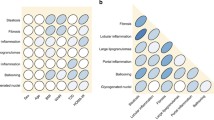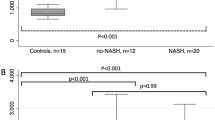Abstract
Background
White adipose tissue (WAT) from visceral adiposity plays an important role in the pathogenesis of non-alcoholic steatohepatitis (NASH). Development of NASH and its progression to fibrosis is partially due to cytokines and adipokines produced by WAT. The aim of this study was to assess the association of hepatic fibrosis and NASH by evaluating the intrinsic differences in the inflammatory cytokine signaling in the visceral adipose tissue obtained from morbidly obese patients.
Methods
We used targeted microarrays representing human genes involved in the inflammatory and fibrogenic reactions to profile visceral adipose samples of 15 well-matched NASH patients with and without fibrosis. Additionally, visceral adipose samples were subjected to real-time polymerase chain reaction profiling of 84 inflammations related genes.
Results
Eight genes (CCL2, CCL4, CCL18, CCR1, IL10RB, IL15RA, and LTB) were differentially expressed in NASH with fibrosis. Additionally, an overlapping but distinct list of the differentially expressed genes were found in NASH with type II diabetes (DM; IL8, BLR1, IL2RA, CD40LG, IL1RN, IL15RA, and CCL4) as compared to NASH without DM.
Conclusions
Inflammatory cytokines are differentially expressed in the adipose tissue of NASH with fibrosis, as well in NASH with DM. These findings point at the interaction of adipose inflammatory cytokines, DM, hepatic fibrosis in NASH, and its progression to cirrhosis and end-stage liver disease.


Similar content being viewed by others
References
Machado M, Cortez-Pinto H. Non-alcoholic fatty liver disease and insulin resistance. Eur J Gastroenterol Hepatol. 2005;17:823–6.
Ong J, Elariny H, Collantes R, et al. Predictors of nonalcoholic steatohepatitis and advanced fibrosis in obese patients. Obes Surg. 2005;15(3):310–15.
Nugent C, Bai CH, Elariny H, et al. Improvement of metabolic syndrome after laparoscopic bariatric surgery. Obes Surg. 2008;18(10):1278–86.
Baranova A, Gowder SJ, Schlauch K, et al. Gene expression of leptin, resistin, and adiponectin in the white adipose tissue of obese patients with non-alcoholic fatty liver disease and insulin resistance. Obes Surg. 2006;16:1118–25.
Baranova A, Schlauch K, Elariny H, et al. Gene expression patterns in the hepatic tissue and in the visceral adipose tissue of patients with non-alcoholic fatty liver disease. Obes Surg. 2007;17(8):1111–8.
Baranova A, Collantes R, Schlauch K, et al. A comparison of serum levels and gene expression of leptin, resistin and adiponectin in the adipose tissue of obese patients with non-alcoholic fatty liver disease and insulin resistance. Obes Surg. 2006;16(9):1118–25.
Lee YH, Pratley RE. The evolving role of inflammation in obesity and the metabolic syndrome. Curr Diab Rep. 2005;5:70–5.
Matteoni CA, Younossi ZM, Gramlich T, et al. Nonalcoholic fatty liver disease: a spectrum of clinical and pathological severity. Gastroenterology 1999;116:1413–9.
Marchesini G, Brizi M, Bianchi G, et al. Nonalcoholic fatty liver disease. A feature of the metabolic syndrome. Diabetes 2001;50:1844–50.
Gramlich T, Kleiner DE, McCullough AJ, et al. Pathologic features associated with fibrosis in non-alcoholic fatty liver disease. Human Pathol. 2004;35:196–99.
Sasaki N, Ueno T, Morita Y, et al. Usefulness of serum hepatic fibrosis markers in the diagnosis of nonalcoholic steatohepatitis (NASH). Hepatogastroenterology 2006;53:678–81.
Hubscher SG. Histological assessment of non-alcoholic fatty liver disease. J Clin Gastroenterol. 2006;40:S5–10.
Weltman MD, Farrell GC, Liddle C. Increased hepatocyte CYP2E1 expression in a rat nutritional model of hepatic steatosis with inflammation. Gastroenterology 1996;111:1645–53.
Geerts A. History, heterogeneity, developmental biology, and functions of quiescent hepatic stellate cells. Semin Liver Dis. 2001;21:3113–35.
Fain JN. Release of interleukins and other inflammatory cytokines by human adipose tissue is enhanced in obesity and primarily due to the nonfat cells. Vitam Horm. 2006;74:443–77.
You T, Nicklas BJ. Chronic inflammation: role of adipose tissue and modulation by weight loss. Curr Diabetes Rev. 2006;2:29–37.
Jarrar MH, Baranova A, Collantes R, et al. Adipokines and cytokines in non-alcoholic fatty liver disease. Aliment Pharmacol Ther. 2008;27:412–21.
Pradhan A. Obesity, metabolic syndrome, and type 2 diabetes: inflammatory basis of glucose. Nutr Rev. 2007;65:S152–56.
Fain JN, Madan AK. Regulation of monocyte chemoattractant protein 1 (mcp-1) release by explants of human visceral adipose tissue. Int J Obes (Lond). 2005;29:1299–307.
Sell H, Eckel J. Monocyte chemotactic protein-1 and its role in insulin resistance. Curr Opin Lipidol. 2007;18:258–62.
Kanno K, Tazuma S, Nishioka T, et al. Angiotensin II participates in hepatic inflammation and fibrosis through MCP-1 expression. Dig Dis Sci. 2005;50:942–8.
Zeyda M, Farmer D, Todoric J, et al. Human adipose tissue macrophages are of an anti-inflammatory phenotype but capable of excessive pro-inflammatory mediator production. Int J Obes (Lond). 2007;31:1420–28.
Cipollone F, Chiarelli F, Davì G, et al. Enhanced soluble CD40 ligand contributes to endothelial cell dysfunction in vitro and monocyte activation in patients with diabetes mellitus: effect of improved metabolic control. Diabetologia 2005;48:1216–224.
Afford SC, Ahmed-Choudhury J, Randhawa S, et al. CD40 activation-induced, Fas-dependent apoptosis and NF-kappaB/AP-1 signaling in human intrahepatic biliary epithelial cells. FASEB J. 2001;15:2345–54.
Wieckowska A, Papouchado BG, Li Z, et al. Increased hepatic and circulating interleukin-6 levels in human nonalcoholic steatohepatitis. Am J Gastroenterol. 2008;103:1372–79.
Fontana L, Eagon JC, Trujillo ME, et al. Visceral fat adipokine secretion is associated with systemic inflammation in obese humans. Diabetes 2007;56:1010–13.
Acknowledgments
This study was partly supported by the Liver Disease Outcomes Fund of the Center for Liver Diseases at Inova Fairfax Hospital and a Seed Grant from Inova Health System.
Financial Disclosure
None.
Author information
Authors and Affiliations
Corresponding author
Electronic Supplementary Material
Supplementary tables are located at the authors’ website (http://www.gmu.edu/departments/mmb/baranova/pages/focus-fibrosis-adipose.htm).
Supplementary Table 1
List of human genes profiled in adipose samples of NASH patients by microarray. Genes that were present only in microarray experiment, but not in RT-PCR experiment, are in italic (DOC 174 kb)
Supplementary Table 2
List of human genes profiled in adipose samples of NASH patients by RT-PCR. Genes that were present only in RT PCR experiment, but not in microarray experiment, are in italic (DOC 134 kb)
Supplementary Table 3
Cytokine signaling-related (CSR) genes expressed in the adipose tissue in each of the patients’ cohorts (DOC 109 kb)
Rights and permissions
About this article
Cite this article
Estep, J.M., Baranova, A., Hossain, N. et al. Expression of Cytokine Signaling Genes in Morbidly Obese Patients with Non-Alcoholic Steatohepatitis and Hepatic Fibrosis. OBES SURG 19, 617–624 (2009). https://doi.org/10.1007/s11695-009-9814-x
Received:
Accepted:
Published:
Issue Date:
DOI: https://doi.org/10.1007/s11695-009-9814-x




